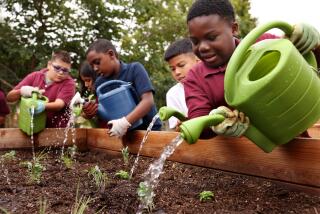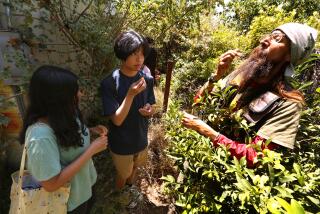Watts Students See Science in a New Light : Education: Laser disc videos bring subject matter alive for classes. Program is designed to strengthen academic performance.
- Share via
A group of sixth-graders sit in a classroom in Watts and watch liquid change to stone on a color television screen. The teacher freezes the frame to quiz the children on the wonders of nature. And hands shoot into the air.
What is “magma?” “The red hot liquid under the Earth’s surface,” answers one girl. And “igneous?” “The rock formed after the magma cools.” They look at a jumble on the screen and recognize the crystals of a mineral. And they can tell with a glance if the mineral is copper or gold.
At 99th Street Elementary School, the laws and mysteries of science are taught by video. A $77,000 grant from the American Honda Foundation has enabled the school to enhance science lessons with laser disc technology for students in kindergarten through the sixth grade. And teachers and administrators hope that the innovative way of teaching will strengthen the academic performance of children labeled to be at risk.
“Many of our children are from low-income families and they’re considered at risk of not graduating high school, of not pursuing a post-secondary education,” said Althea Woods, principal of 99th Street Elementary. “We had to change strategies if we wanted our kids to succeed.”
The grant, announced at a press conference Tuesday, was acquired with the help of a nonprofit group, Technology for Results in Elementary Education (TREE), which is dedicated to financially assisting schools least able to afford the electronic tools that could help underachieving students.
The laser disc program is a key component of a project to raise the science scores of 99th Street Elementary students. Currently the sixth-grade students score between the 17th and 21st percentile on the California Test of Basic Skills. But in exchange for the grant, the school has committed itself over the next three years to ensuring that most of its sixth-graders will do at least as well as half of the students in the state.
Carol Wiersma, science coordinator for the school, said she can already see the difference in the eager faces of her students.
“There is already an enriched enthusiasm,” said Wiersma, whose sixth-grade class has, like the rest of the school, used the program for about a month. “There is a scientific terminology the students are using that they never would have used before.”
Her students agreed the program has heightened their interest in learning science.
“I always had a problem taking books out and reading pages over and over,” said 12-year-old Antonio Gonzalez. “This program makes it more fun and exciting to learn.”
Added 11-year-old Joanna Griffin: “When you’re reading it on a page, you have to imagine it. This way, instead of imagining, you can see it.”
More to Read
Sign up for Essential California
The most important California stories and recommendations in your inbox every morning.
You may occasionally receive promotional content from the Los Angeles Times.










